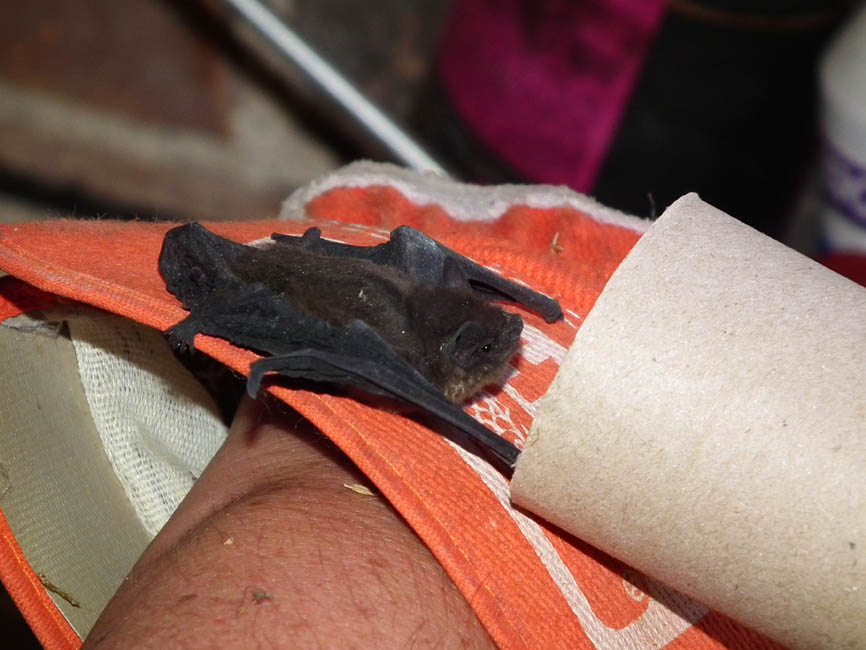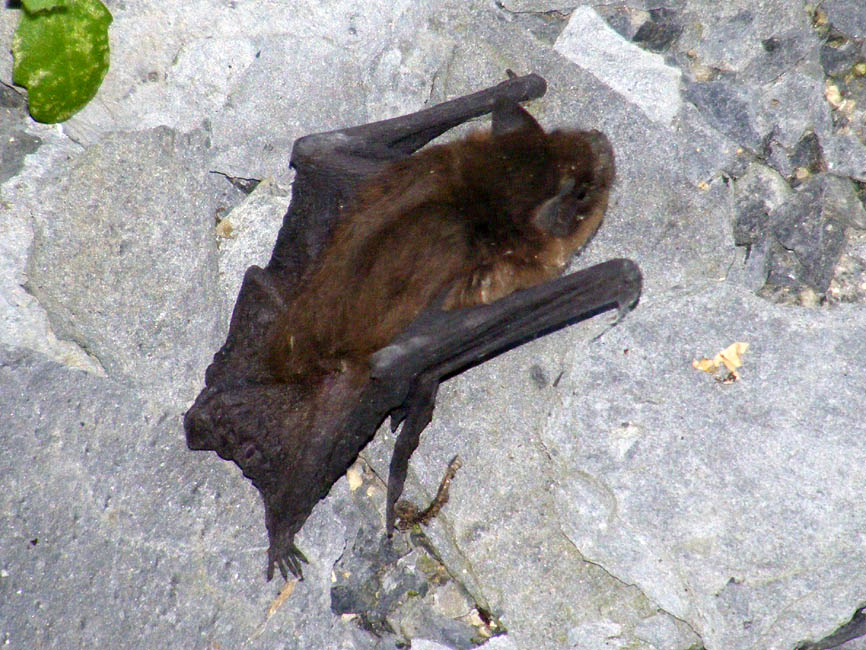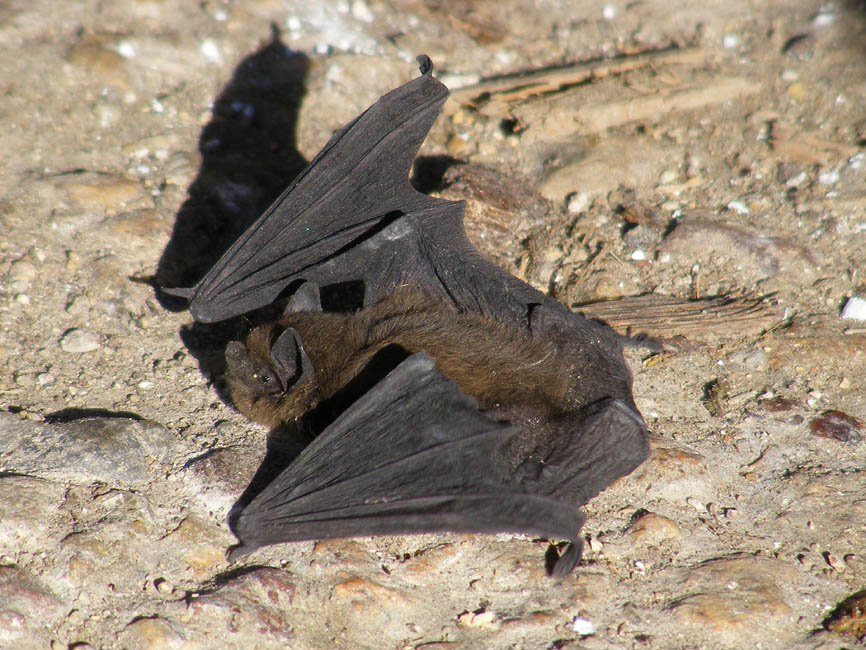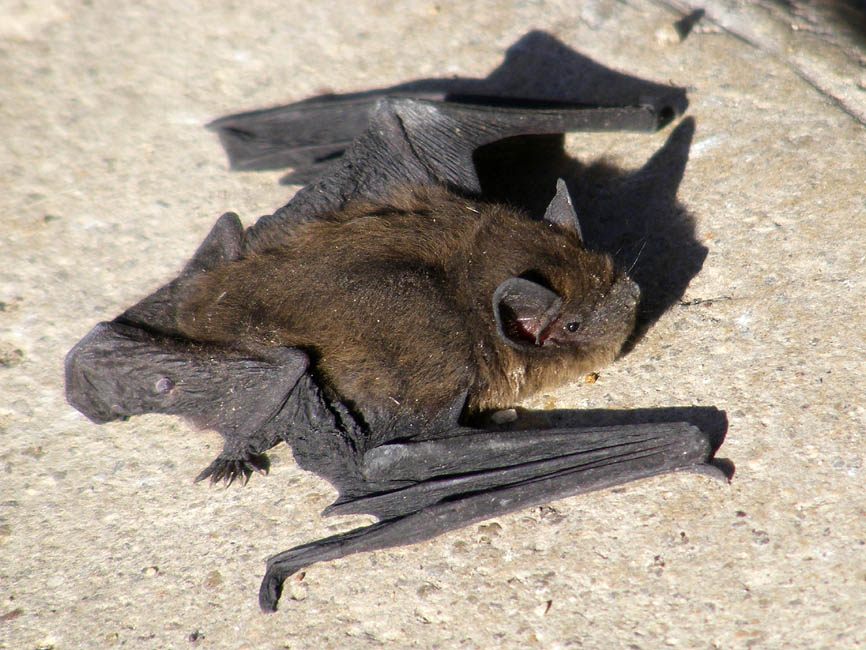 One evening in late July I went out to lock the garage and discovered a bat 'legging' it across the driveway. They can move remarkably rapidly on the ground by swinging their wings forward and using the hooked thumbs as pivot points, waddling behind with their hind feet. Nevertheless, it appeared to be injured, with the left wing being held awkwardly.
One evening in late July I went out to lock the garage and discovered a bat 'legging' it across the driveway. They can move remarkably rapidly on the ground by swinging their wings forward and using the hooked thumbs as pivot points, waddling behind with their hind feet. Nevertheless, it appeared to be injured, with the left wing being held awkwardly. I rushed inside to get the bat rescue gear (gloves and a toilet roll), my camera, and called Simon, so he could come and see the bat. I could only find a huge leather work glove, which meant that when I picked up the bat by gently encouraging it on to the glove, it kept wanting to snuggle down under the capacious wrist band. You are not supposed to touch bats when you rescue them, so this wasn't ideal. Eventually I managed to get it to settle in a crevice in the stones of our granary, but several times it determinedly climbed down and legged it across the grass. I was worried about one of the many neighbourhood cats spotting it. As small mammal specialists they would make very short work of an injured and grounded bat.
I rushed inside to get the bat rescue gear (gloves and a toilet roll), my camera, and called Simon, so he could come and see the bat. I could only find a huge leather work glove, which meant that when I picked up the bat by gently encouraging it on to the glove, it kept wanting to snuggle down under the capacious wrist band. You are not supposed to touch bats when you rescue them, so this wasn't ideal. Eventually I managed to get it to settle in a crevice in the stones of our granary, but several times it determinedly climbed down and legged it across the grass. I was worried about one of the many neighbourhood cats spotting it. As small mammal specialists they would make very short work of an injured and grounded bat.I was interested to note that whenever it encountered a spiderweb that it got entangled in it stopped and carefully removed all the strands. It was clearly small enough to be seriously impeded by the sticky filaments. It reminded me that when I worked for the National Trust we always made sure that house staff knew that the triangular sticky insect monitoring traps were not to be used anywhere that a bat might be tempted down to eat the trapped insects. We had heard of a few cases where the bat itself got trapped on the sticky surface of the cardboard.
 We can only speculate that it had been roosting for the day under the wooden palisade gable of our garage. The palings are in poor condition and are now rather loose. They flap a bit in the wind and maybe it got knocked from his perch. Unlike the previous bat we had to rescue, who was outraged at us accidentally knocking it to the ground when we removed a piece of rotten lime mortar, this little chap was entirely passive and unaggressive. It just looked around and sniffed the air a bit, but did not appear distressed by being handled or attempt to bite.
We can only speculate that it had been roosting for the day under the wooden palisade gable of our garage. The palings are in poor condition and are now rather loose. They flap a bit in the wind and maybe it got knocked from his perch. Unlike the previous bat we had to rescue, who was outraged at us accidentally knocking it to the ground when we removed a piece of rotten lime mortar, this little chap was entirely passive and unaggressive. It just looked around and sniffed the air a bit, but did not appear distressed by being handled or attempt to bite. Very sadly, in the morning, I found a little brown furry body in the driveway. I took the opportunity to measure it and confirm the identity. It was a pipistrelle, only 3.5cm from nose to rump, with a 2.5cm tail. This is only just within the size range for an adult pipistrelle, so I assume it was one of this year's youngsters. Tim pointed out to me that bats dehydrate very quickly and that it is a good idea to offer them a drink by placing a straw holding water in front of them (a thumb over the end will hold the water in the straw and allow the bat to lap water from the other end). I wish I'd thought to do that now.
Very sadly, in the morning, I found a little brown furry body in the driveway. I took the opportunity to measure it and confirm the identity. It was a pipistrelle, only 3.5cm from nose to rump, with a 2.5cm tail. This is only just within the size range for an adult pipistrelle, so I assume it was one of this year's youngsters. Tim pointed out to me that bats dehydrate very quickly and that it is a good idea to offer them a drink by placing a straw holding water in front of them (a thumb over the end will hold the water in the straw and allow the bat to lap water from the other end). I wish I'd thought to do that now. The little body is now in a tomato pot, providing fertilizer and decomposing to bones so I can examine the teeth later and determine which species of pipistrelle it is.
The little body is now in a tomato pot, providing fertilizer and decomposing to bones so I can examine the teeth later and determine which species of pipistrelle it is.Susan

10 comments:
Yes, Susan. We've had rain and heavy dews recently... but it isn't necessarily dehydration. Did you weigh it? It could have been starved... we've noticed a distinct reduction in the moth cover on the windows of an evening... even the "krill" is heavily reduced. We've no bees to speak of here, and whilst there is a small 'house' fly [that's about to get swatted if it yet again comes and sits on the bit of the screen I am trying to look at as I type], there are damned few of them around either. [Right that's it; he's had it!] Insect numbers are right down this last fortnight!!
Poor little fellow! But you shouldn't blame yourself for not giving it some water. It was probably too weak or too badly injured anyway to survive. At least you tried to save it. Martine
P.S. That garden glove looks familiar. I'm sure C. will be happy to see that you are making good use of it ;)
Something we don't encounter here in Mentone. Interesting.
Leon
Tim: Bee numbers seem a little low, but not disasterous. Many fly families are doing well or OK, including Muscidae. Some are not (Craneflies - which I predicted last year, due to dessication of larvae in the drought). Dragonflies are having a better year than last year, and wood boring and dung beetle numbers seem good. Some leaf beetles are in good numbers, but a few species are down. Leps are having a very poor year, but a few species are making a late recovery.
Martine: I'd forgotten that's where it came from! We use the various excellent tools he brought often though.
Leon: are you a bit urban? Bats aren't huge fans of street lights.
Susan, we've no bees at all at present... very few flies of any kind... not many night flying leps... much fewer day flying than a week ago.
Whilst I saw about half a doz bee-eaters last week at the usual spot, there haven't been any since!
I think they passed on through....
All the crickets and grasshoppers seem to have vanished too!! All we've got at the moment are some very large, but still immature, Field Crickets in the potager potato patch.
Tim: Must be just you. Grasshoppers, bush crickets, coneheads, praying mantises, stick insects all appear to be doing well this year. Flowering ivy is covered in hymenoptera and diptera just like it ought to be.
Tim: forgot to mention - I didn't weigh it, as a) I didn't think to; and b) I don't have any scales sensitive enough.
We had plenty of insects until about a week and a half ago... since then, they've all but vanished. We've had some spraying going on locally, but as there are no young growing crops on the 'bare' ground, I am presuming that it is just weedkillers that are being put down to kill off weedlings; I hope.
Why aren't you supposed to touch bats? Is this just in Europe?
Being in country Victoria, we get bats that come inside and fly around and around and around for ages before alighting on a wall. I then usually use a tea towel to scoop them up and relocate outside before the cats take an interest.
Andres: Bats worldwide carry rabies and closely related diseases. France was declared rabies free with the exception of flying mammals 10-15 years ago. Theoretically you could catch lyssavirus (closely related to rabies) from a French bat, but no one ever has. Australian bats carry a fairly serious looking arsenal of these viruses in the rabies family, but I don't know what the figures for transfer to humans is. I think a lot of scientists are worried about it though.
Post a Comment